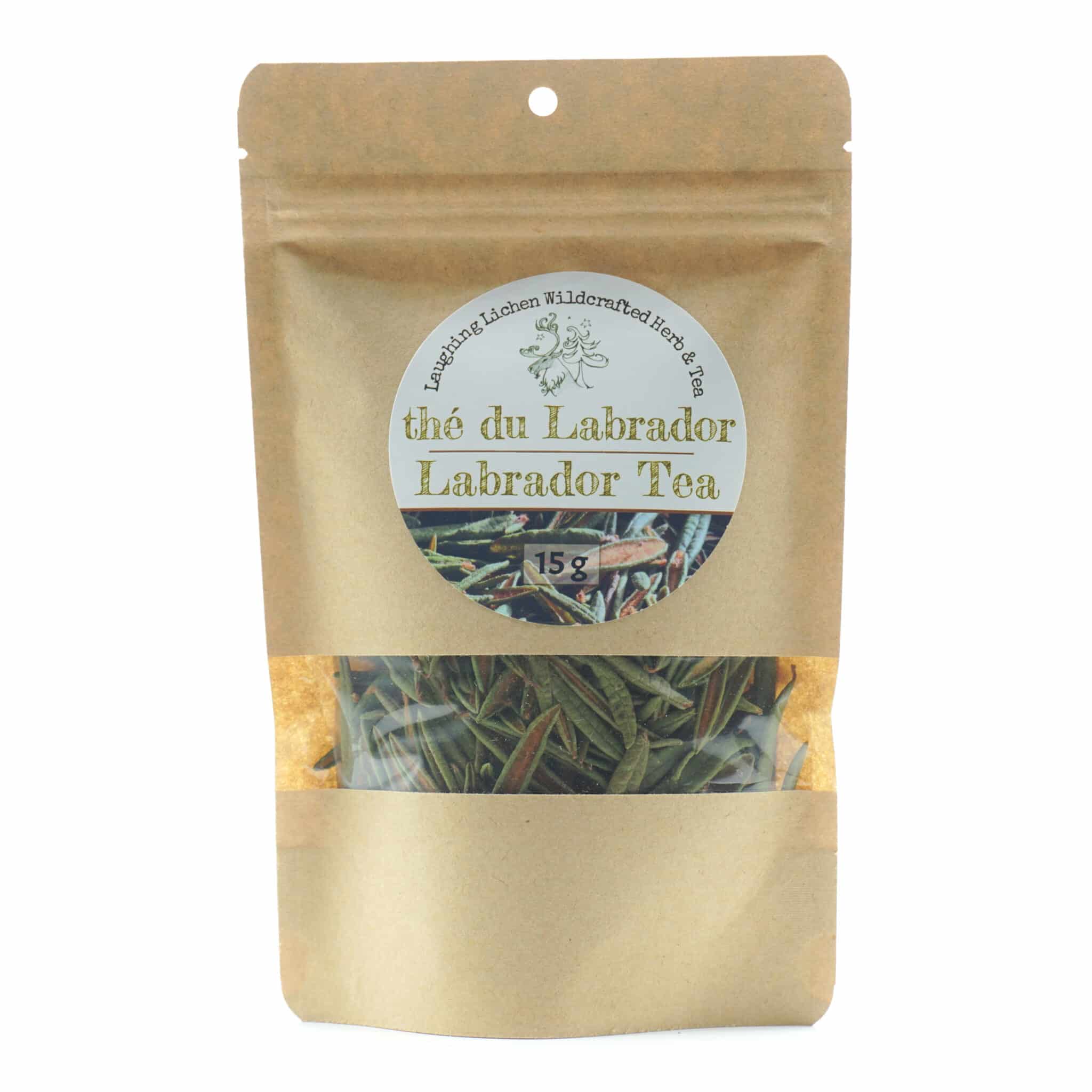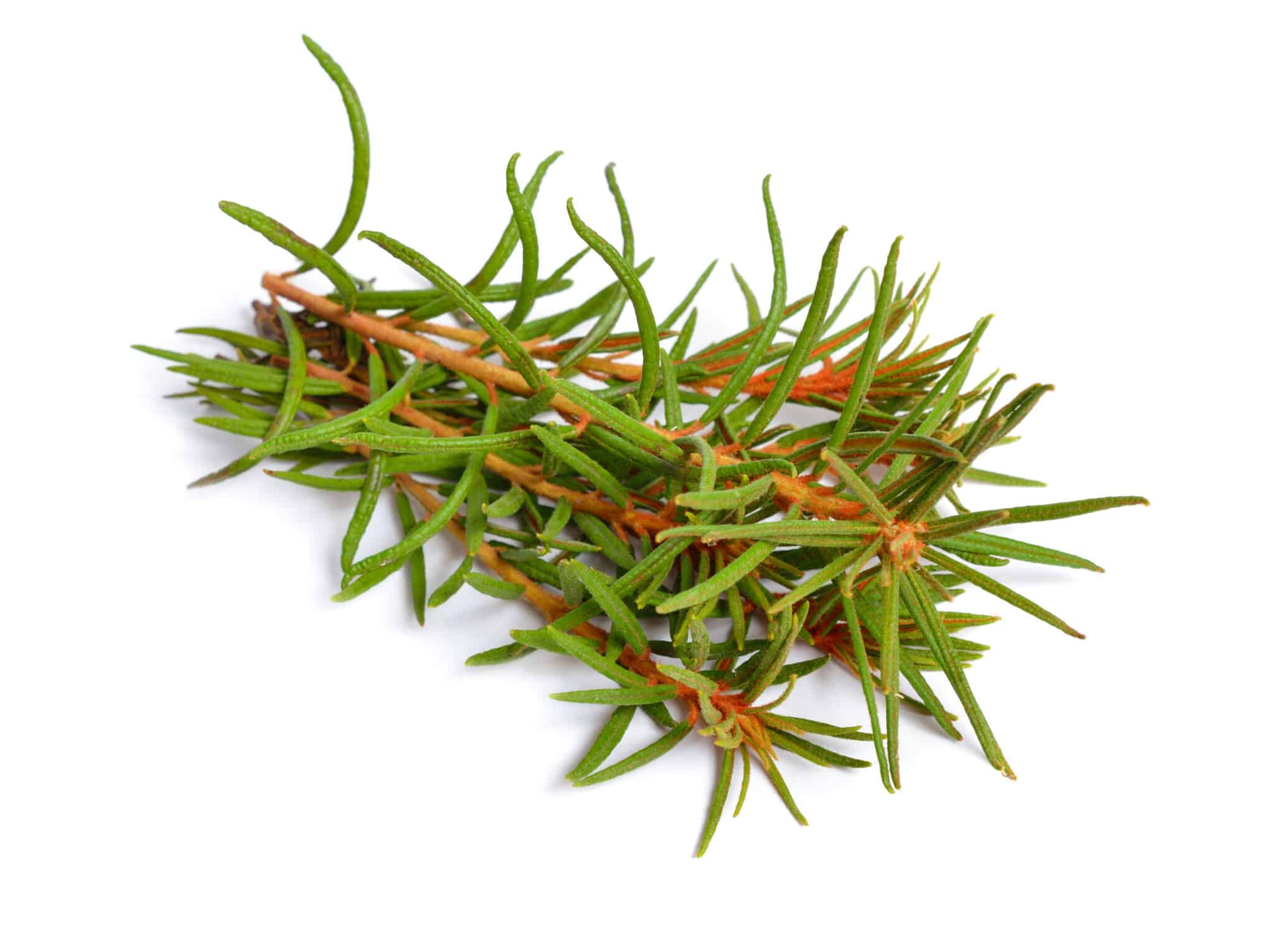Labrador Tea (Ledum groenlandicum) is a small and fragrant perennial slow-growing shrub that is found in bogs, swamps, and forests of Canada and northern United States. It belongs to the Ericaceae (Heath or Heather family). As with many other species of the Heath Family, they thrive in acidic ground conditions. When so many other plants lay dormant, the Labrador is able to bear the harsh winters and finally blooms small white flowers in the spring. Upon reaching maturity, the leaves are highly recognizable by their curled-under edges and the rusty orange brown underneath. Labrador tea provides some forage to deer and moose, usually in the winter months when no other food source is available.
As this shrub thrives in wet and organically rich areas, it can generally survive wildfires as its root crowns and rhizomes have been found deep in the earth’s organic layers. As one of the first plants to recolonize following a forest fire, this plant actually grows rather quickly after the fire, unlike its typically slow growth pattern.
Harvesting:
Due to Labrador Leaf Tea’s evergreen nature, you can harvest the leaves all year long. From a taste and flavour perspective, there are different opinions about the right time to collect the leaves. There are people who prefer the new spring leaves, some who say that the flavor is best when the plant is in bloom, while some prefer the Autumn or Winter leaves.
Tea can be made with fresh or dried leaves, but dried leaves are obviously more versatile.
History:
The fragrant leaves of this plant have been used to make a beverage and also a medicine. A variety of names for the Labrador Tea Leaf include “swamp tea, bog tea, marsh tea, muskeg tea, settler’s tea, and Hudson’s Bay” tea.
The name Hudson’s Bay tea refers to more than just its geographical location. This is a reference to the Hudson’s Bay Company’s use of the tea, both as a product they sold and as a tea they served to its employees in northern areas of Canada. According to the book on Medicinal and Other Uses of North American Plants Historical Survey, the Hudson’s Bay Company imported the dried plants into London as a beverage tea under the name “weesukapuka” (Erichsen-Brown, p.195). A phonetic variation of this name has also been found in the journals of British explorers of the 1700s.
Throughout history, First Nations have used Labrador tea as a natural remedy for various ailments. Many health benefits were believed to be associated with the tea as well as its ability to cure disease.
For example, it was used in the treatment of head colds, stomach pains, taste and its diuretic and emetic properties (Eid et al., 2016)[1]. It was used to treat flu, difficult breathing and stomach problems (Blondeau et al, 2011).
Medicinal use:
Scientific research has demonstrated that many of the ethnomedical assertions about this herb made by traditional medicine may be true. Today, we know from a recent study that the methanol found in the rhododendron Labrador leaves possesses “analgesic, anti-inflammatory, antimicrobial, antiviral, antifungal and insecticidal potential” (Dampc, Luczkiewicz., 2013)[1]. Recent research has also suggested “promising anti-diabetic, antioxidant and anticancer properties” (Dufour et al., 2007)[2].
How to Make Labrador Leaf Tea:
Add about 2-4 Labrador tea leaves (1 teaspoon) per teacup or mug.
Boil water. Remove water from heat and let sit 1 minute. Pour water over tea leaves and let steep 5-10 minutes according to your preference for tea strength. Remove leaves from tea. Flavour with honey or lemon as desired.
Recipe Ideas:
Labrador leaves and blueberries are members of the same heather family. The two can be mixed together to create this sweet and refreshing Iced Blueberry Labrador Tea.
Ingredients:
- 8 cups made from Labrador Leaf Tea
- 2 cups of blueberries (fresh or unfrozen)
- 1/4 cup brown sugar or 2 tablespoons honey
- 1 cup water
- 1 tablespoon lemon juice
Put blueberries and water in a large saucepan and bring to a boil. After the blueberries break down, reduce the heat and simmer for about 5 minutes, stirring often. Mix blueberries with brewed Labrador tea. Stir in honey or brown sugar to the blueberry tea mixture; let cool for about 30 minutes until it reaches room temperature. Place in the refrigerator until cold, about 2 hours. Through a cheesecloth-lined sieve, strain the mixture into a pitcher. Stir in the lemon juice. Pour over ice and enjoy!
Wilderness Manufacturing
Each year, this flavorful Labrador Leaf tea is foraged in small batches at our remote “off-the-grid” wilderness facility located deep in the Northwest Territories boreal forest. Our entire facility is run using solar energy. This ensures that the air-drying of the collected herbs is done in a location far from any pollutants or contaminations. Our harvesting locations are in pristine virgin forests (old-growth), as here in the Northwest Territories of Canada, there has been very little development or natural resource activity over the years.
Storage:
When dried, Labrador leaves have a fantastic shelf life. Keeping them away from the light will prevent them from becoming too dry. To preserve the fragrance, store it in a dark glass or stainless steel container.
[1] Eid HM, Ouchfoun M, Saleem A, Guerrero-Analco JA, Walshe-Roussel B, Musallam L, Rapinski M, Cuerrier A, Martineau LC, Arnason JT, Haddad PS. A combination of (+)-catechin and (-)-epicatechin underlies the in vitro adipogenic action of Labrador tea (Rhododendron groenlandicum), an antidiabetic medicinal plant of the Eastern James Bay Cree pharmacopeia. J Ethnopharmacol. 2016 Feb 3;178:251-7. doi: 10.1016/j.jep.2015.12.021. Epub 2015 Dec 18. PMID: 26707751. [1] Dampc A, Luczkiewicz M. Rhododendron tomentosum (Ledum palustre). A review of traditional use based on current research. Fitoterapia. 2013 Mar;85:130-43. doi: 10.1016/j.fitote.2013.01.013. Epub 2013 Jan 23. PMID: 23352748. [1] Dufour D, Pichette A, Mshvildadze V, Bradette-Hébert ME, Lavoie S, Longtin A, Laprise C, Legault J. Antioxidant, anti-inflammatory and anticancer activities of methanolic extracts from Ledum groenlandicum Retzius. J Ethnopharmacol. 2007 Apr 20;111(1):22-8. doi: 10.1016/j.jep.2006.10.021. Epub 2006 Oct 26. PMID: 17156957.




Connie Kastning (verified owner) –
We have only had this tea twice, so I find this too early to rate. Nice change. Perhaps it will be our favorite? Love your company and products. Thank you
Linda Johnson (verified owner) –
I am not sure this is my current order as it got stuck in the postal strike somewhere, but it was a refill for my previous order for this tea because I loved it so much. It’s soothing and really relaxes me before bed. Looking forward to receiving more when the strike is over – the teas and the service here are first rate.
Andre Cyr (verified owner) –
Matt (verified owner) –
Anonymous (verified owner) –
Krystin (verified owner) –
Coral D. (verified owner) –
Anonymous (verified owner) –
Stephanie (verified owner) –
The product was wonderful and a big hit at the World’s Oatmeal Competition I took it to! However, very disappointed in the shipping costs considering I’m in the same city.
Michael W. (verified owner) –
This is a truly unique taste – I highly recommend it for those who seek to experience something new.
Arthur (verified owner) –
Travera J. (verified owner) –
Great quality tea, and it was securely packaged and shipped. Would recommend.